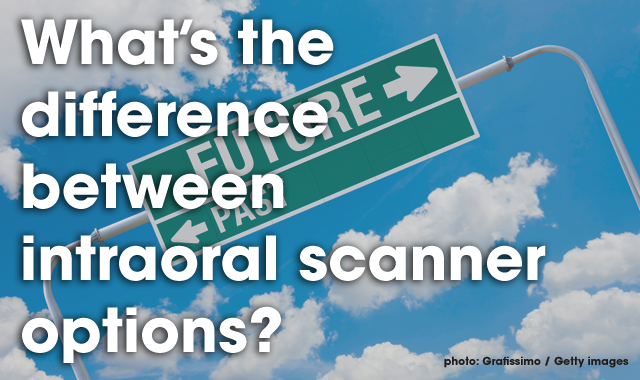Unpacking the differences in intraoral scanning options
Dental Products Report asked a number of experts to unpack the differences in some of the most popular models of intraoral scanners.

“Dentists often ask me ‘What’s the best scanner?’” says Dr. Mike DiTolla, Dentsply Sirona, Director of Clinical Affairs. “That’s like saying ‘What’s the best car?’ It depends. Are you going to be thrilled by driving a Tesla or would you be happier having a four-year-old Chevy Suburban because you have to drag the kids around? It’s tough to answer what’s the best because it’s going to be a different answer for every dentist.”
DPR recently covered the advantages of digital impressions in detail. But we also wanted to know what some of the deciding factors might be for practices thinking about making the leap to digital impressions. So we asked some of the industry's experts about the features of the various intraoral scanning options, and what dentists need to be looking for. Here’s what our experts had to say on the subject:
Dr. John Flucke, Private Practice for 29 years
[Many scanners now] just don’t require powder, which is a big deal. Some people will tell you the powder is not a big deal. Well, let me tell you when you compare it to not having powder, it is a big deal. Any sales person will tell you their negative features aren’t a big deal, but they are.
Cover story: Are digital impressions REALLY the best choice?
Another consideration is the size of the cameras on some of the units. Some have big cameras, and that’s a big deal. We do just fine with the iTero camera, which is larger. But if somebody said, ‘Oh, we’ve got this new camera that is the size of an intraoral camera. Which would you prefer to use?’ I wouldn’t even think about it. I’d take the little camera. Even though we make the big one work, I’d rather have the little one.
Josie Bunning, U.S. Procedure Marketer for Digital Equipment at 3M Oral Care
The 3M True Definition Scanner is proven to be more accurate-and more consistently accurate-than other leading intraoral scanners. Powder adds a pattern to the otherwise featureless surface of the teeth, helping with the registration of the 3D patches obtained during scanning, improving performance and accuracy. Consider this endorsement from 3M True Definition Scanner User Dr. Parag Kachalia:
“Accuracy trumps any kind of dusting or powdering and especially with a scanning spray that is incredibly accurate. Today it really is a very, very light dusting that is occurring. It doesn’t get in the way of my patients at all. It doesn’t impede my workflow. I’m comfortable that my restoration is going to fit.”
Unlike systems that are “closed,” our scanner’s digital impression files can be used with any system that accepts STL files.
The 3M True Definition Scanner has a reasonable price point of $15,995 plus an affordable monthly data plan and new software updates at no additional charge.
Carrie Nelson, Director of Marketing Planmeca USA–CAD/CAM
The PlanScan is a total plug-and-play scanner built with an open architecture system. Any kind of scan taken can be sent to a lab, to a specialist or any other third party.
It is fast, precise and scans in color. We have various sized tips that come with it for use with different types of patients and for whatever you’re doing. There’s a tip that would fit in a child’s mouth and other angled-type tips.
It’s an individual scanner, but part of a full system allowing same-day dentistry as well. If you want to keep working with your lab, you can purchase the scanner and a laptop separately. But if you want to do same-day dentistry, it has the scanning software, the design software and a mill to do it all in-house if you wanted. So it’s scalable, allowing you to practice dentistry the way you want to practice dentistry.
Dr. Mike DiTolla, Dentsply Sirona, Director of Clinical Affairs
One of the decisions is whether you’re OK with powdering. Considering that all of the commercially available digital scanners are more accurate than the combination of traditional polyvinyl/polyether materials and die stone, the vast majority of dentists opt for powder-free.
The CEREC system outputs a proprietary file to take advantage of the robust CEREC inLab software. Any laboratory can accept these files with the inLab software, and this allows the dentist and lab to have the same software, allowing your lab to design crowns for you on challenging cases. Full service laboratories, like Glidewell, accept digital impressions from all digital scanning systems and don’t care which one you use.
Look at the capabilities. If you want to do something like Invisalign or ClearCorrect, a couple systems have direct links to those systems. If you place or restore a lot of implants, make sure the system will handle that, especially if you think you may want to mill your own surgical guides.
If you stick to those main categories-powder versus no powder, proprietary versus non-proprietary, laboratory preferences and whether you want to use any other functions like orthodontics or implants, you won’t go wrong.
Just make sure you get it into your hands and see if it feels intuitive before you commit to it and buy it.
Product Bites – January 19, 2024
January 19th 2024Product Bites makes sure you don't miss the next innovation for your practice. This week's Product Bites podcast features new launches from Adravision, Formlabs, Owandy Radiology, Henry Schein Orthodontics, Dental Creations, and Dental Blue Box. [5 Minutes]
Product Bites – January 12, 2024
January 12th 2024The weekly new products podcast from Dental Products Report is back. With a quick look at all of the newest dental product launches, Product Bites makes sure you don't miss the next innovation for your practice. This week's Product Bites podcast features new launches from Videa Health and DentalXChange.